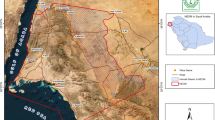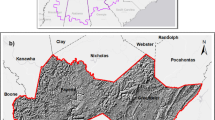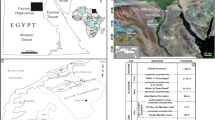Summary
This paper attempts to demonstrate that the study of geomorphology can provide a useful framework for understanding the natural processes and factors that are critical for the development of ecologically sustainable and economically viable greenery projects in the desert and arid environments.
The surface of Kuwait was subdivided into 15 geomorphic zones and each zone was assessed in terms of its potentiality for establishing greenery activities. The assessment considered the implications of relief, soil type and fertility, aeolian processes, sand encroachment and presence or absence of indurated bedrocks and pavements for the greenery plan of Kuwait. Accordingly, areas with the most favourable conditions for revegetation were identified and strategies for enhancing the conservation value and sustainability of the greenery programme were outlined.
The study pointed out that while the adopted approach provided useful environmental guidelines at the planning level, further investigations would be required, at the project level, if the principles of ecologically sustainable development were to be fully incorporated within such a large scale greenery undertaking.
Similar content being viewed by others
References
Alawadi, J.A. 1988. Methods for the stabilization of dunes and drifting sand,Environmental Issues, 63 pp. Kuwait Environmental Protection Society, Kuwait.
Al Bakri, D., Foda, M., Behbehani, M. and Shublaq, W. 1985.Environmental Assessment of the Intertidal Zone of Kuwait, Final Report, Vol. 1, KISR 1687, Kuwait.
Al Bakri, D., Kittaneh, W. and Shublaq, W. 1988a. Sedimentological characteristics of the surficial deposits of the Jal Az-Zor area, Kuwait,Sedimentary Geology,59, 295–306.
Al Bakri, D., Rejehrt, M., Al-Sulaimi, J., and Kittaneh W. 1988b.Assessment of the Sand and Gravel Resources of Kuwait: Geology and Geomorphology, Final Report, Vol.3, KISR 2830, Kuwait.
Al Bakri, D., Kittaneh, W., Shublaq, W. and Suleiman, N. 1990. Environmental Aspects of the Greenery Plan of Kuwait. Technical Report (Draft), SPP-8, KISR, Kuwait
Al-Kulaib, A. 1984.The Climate of Kuwait. Meteorological Department, Directorate General of Civil Aviation, Kuwait.
Caulton, E. and Keddic, D. 1989. Environmental conservation problems in Kuwait.The Environmentalist,9(3), 219–225.
Charchallis, G., Ritter, J., Katir, D. and Collett, B. 1989. Strategic and Master Plan for Greenery Development and Environmental Enhancement of Kuwait. First Technical Report (Draft), SPP-8, KISR, Kuwait.
DSMG. 1992.Dryland Salinity Management in the Murray-Darling Basin. Dryland Salinity Management Group, Murray-Darling Basin Commission, Fyshwick, Australia.
Foda, M., Gharib, I., Al-Hashash, M. and AL-Kadi, A. 1984.Assessment of Sand Encroachment Erodibility Problems in Kuwait. Technical Report, KISR 1297, Kuwait.
Greenwood, E. 1992, The use of vegetation in salinity management. Catchment of Green, National Conference on Vegetation and Water Management, 23–26 March, Adelaide, Australia.
HGG. 1981.Photogeological Survey of the State of Kuwait. Report prepared by Hunting Geology and Geophysics Ltd for Kuwait Oil Company, Kuwait.
Khalaf, F., Gharib, I. and Al-Hashash, M. 1984. Types and characteristics of the recent surface deposits of Kuwait.J. Arid Environment,7, 9–33.
Khalaf, F. and El-Sayad, M. 1989. Fossil cyclic calcrete in the Kuwait Group clastic deposits of Kuwait, Arabian Gulf.Geologische Rundschau,78(2), 525–536.
McCaughey, W. 1992. Greening of Australia Campaign. Catchment of Green, National Conference on Vegetation and Water Management, 23–26 March, Adelaide, Australia.
O'Laughlin, E. 1992. Manipulating the water balance to reduce waterlogging. Catchment of Green, National Conference on Vegetation and Water Management, 23–26 March, Adelaide, Australia.
Omar, S., El-Bagouri, I., Anwar, M., Kalaf, F. and Nassef, A. 1988.Measures to Control Mobile Sand in Kuwait, Environmental Assessment and Control Measures. Final report, Vol.1, KISR 8790, Kuwait.
Picha, F. 1978. Depositional and diagenetic history of Pleistocene and Holocene oolitic sediments and sabkhas in Kuwait, Persian Gulf.Sedimentology,25, 427–450.
Pitty, A. 1989. Interaction Between the Implementation of the Greenery Project and Earth/Environmental Science Factors. A preliminary report, SPP-8, KISR, Kuwait.
Safar, I. 1985.Dust and Dust Storms in Kuwait. Meteorological Department, Directorate General of Civil Aviation, Kuwait
Author information
Authors and Affiliations
Additional information
Dr Dhia Al Bakri is a Lecturer in Environmental Management at the Orange Agricultural College, University of Sydney, Australia. He worked as a Research Scientist for the Kuwait Institute for Scientific Research from 1980 to 1990. During that time Dr Al Bakri undertook a wide range of studies and research projects within the context of Environmental and Earth Sciences.
Rights and permissions
About this article
Cite this article
Bakri, D.A. A geomorphic framework for developing a sustainable greenery programme in arid environments. Environmentalist 14, 271–282 (1994). https://doi.org/10.1007/BF02239789
Issue Date:
DOI: https://doi.org/10.1007/BF02239789




